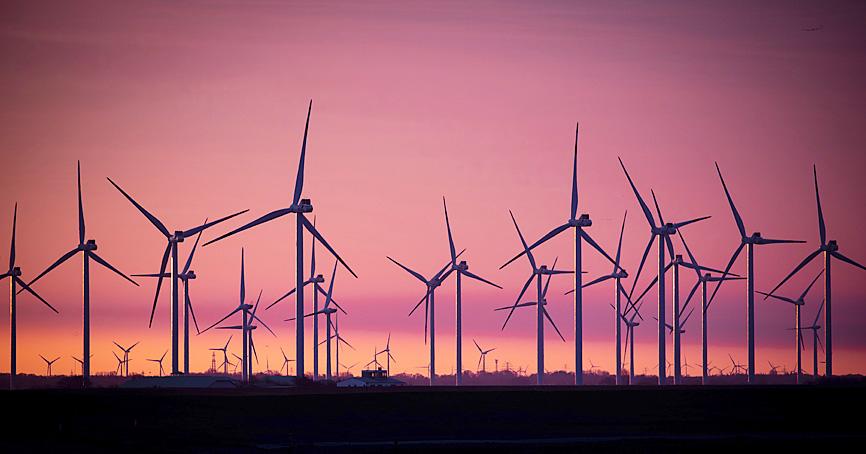Floating systems for offshore wind farms in deeper waters are key to fulfilling Taiwan’s wind energy goals and the government should commit to a plan supporting the new technology, developers and industry insiders said at the Wind Energy Asia forum in Kaohsiung on Thursday.
Floating systems were first developed for the oil and gas industries, and there are many pilot projects for floating offshore wind farm systems around the world, including in Japan and the UK.
However, the cost is still prohibitively high, RWE Renewables Taiwan business development head Chong Yu-foong (張友鴻) said.

Photo: AP
“It is not correct to call it an immature technology, because we already know that it works,” Chong said. “The challenge is to make it commercially viable.”
Experts say that 50m is widely considered to be the deepest at which fixed-bottom wind turbines can be installed, while some think that the envelope can be pushed to 60m, with the costs and complications of installing the turbines increasing with the depth.
Taiwan’s prime shallow-water sites are off the shore of Changhua County in the west, where demand for electricity is high.
“Demand is centered in the northwest of Taiwan,” Chong said.
“The northwest also has the greatest wind yields, but waters there are more than 50m deep,” he added.
Chong estimates that there are only about 10 gigawatts (GW) of offshore wind sites around Taiwan that are shallow enough for fixed-bottom installations.
About 5.5GW of that capacity has been allocated to various developers as a part of the government’s “phase 2” offshore wind development plan.
This means that to complete the “phase 3” plan, developers would have no choice but to move to deeper waters.
There might also be “supply-chain opportunities” for domestic manufacturers, as there are currently no dominant established players specializing in floating offshore wind systems, Chong said.
“Traditional electricity cables are hard and stiff, but floating systems require flexible, dynamic cables. This is just one of the new manufacturing opportunities,” he said.
If Taiwan takes advantage by moving first in the Asia-Pacific region, Taiwanese floating system suppliers could have an advantage going forward, he said.
“With the appropriate government support, we could see the formation of a floating wind industrial cluster here in Taiwan,” Chang said. “If that does not happen, the cluster will probably be in Japan.”
Describing floating systems as “feasible and bankable,” Great Circle Wind Associates (大環風能管理服務) managing partner Eddie Yang joined other developers in calling for the government to establish two to three “stepping stone” projects of about 100 megawatts (MW) in size, supported by a feed-in tariff scheme.
“Taiwan does not need a demonstration project, we can go straight to 90MW, try three different floating systems and see what works best,” Yang said.
However, not everybody is expecting floating systems to become a reality any time soon.
Wind industry consultant Manuel Zehr said that he is skeptical that floating systems would become cheap and reliable enough to be in use commercially.
“Maybe in eighty years,” said Zehr, director of international projects with Formosan Business Support Co, recounting watching a streaming demonstration of a floating turbine that toppled in the water.
Gert Eriksen, head engineer of Wind Energy Pro, a staffing and consulting service provider, said that floating systems have pros and cons.
“The advantage is you can build it right in the port — there’s no need for heavy-lift vessels — but the disadvantage is that it is very, very expensive,” Eriksen said.
He said that offshore wind developers have previously taken a chance on new technology.
“It’s just like when we started going to the jacket systems from the monopiles,” Eriksen said. “In the beginning, there was a lot of uncertainty, but now they are the industry standard.”
Wind Energy Asia executive vice president Robert Campbell said that the future is floating systems.
“Two years ago, nobody talked about it,” Campbell added. “Now, everybody is trying to figure out how to do it.”

Among the rows of vibrators, rubber torsos and leather harnesses at a Chinese sex toys exhibition in Shanghai this weekend, the beginnings of an artificial intelligence (AI)-driven shift in the industry quietly pulsed. China manufactures about 70 percent of the world’s sex toys, most of it the “hardware” on display at the fair — whether that be technicolor tentacled dildos or hyper-realistic personalized silicone dolls. Yet smart toys have been rising in popularity for some time. Many major European and US brands already offer tech-enhanced products that can enable long-distance love, monitor well-being and even bring people one step closer to

TRANSFORMATION: Taiwan is now home to the largest Google hardware research and development center outside of the US, thanks to the nation’s economic policies President Tsai Ing-wen (蔡英文) yesterday attended an event marking the opening of Google’s second hardware research and development (R&D) office in Taiwan, which was held at New Taipei City’s Banciao District (板橋). This signals Taiwan’s transformation into the world’s largest Google hardware research and development center outside of the US, validating the nation’s economic policy in the past eight years, she said. The “five plus two” innovative industries policy, “six core strategic industries” initiative and infrastructure projects have grown the national industry and established resilient supply chains that withstood the COVID-19 pandemic, Tsai said. Taiwan has improved investment conditions of the domestic economy

Malaysia’s leader yesterday announced plans to build a massive semiconductor design park, aiming to boost the Southeast Asian nation’s role in the global chip industry. A prominent player in the semiconductor industry for decades, Malaysia accounts for an estimated 13 percent of global back-end manufacturing, according to German tech giant Bosch. Now it wants to go beyond production and emerge as a chip design powerhouse too, Malaysian Prime Minister Anwar Ibrahim said. “I am pleased to announce the largest IC (integrated circuit) Design Park in Southeast Asia, that will house world-class anchor tenants and collaborate with global companies such as Arm [Holdings PLC],”

MAJOR BENEFICIARY: The company benefits from TSMC’s advanced packaging scarcity, given robust demand for Nvidia AI chips, analysts said ASE Technology Holding Co (ASE, 日月光投控), the world’s biggest chip packaging and testing service provider, yesterday said it is raising its equipment capital expenditure budget by 10 percent this year to expand leading-edge and advanced packing and testing capacity amid strong artificial intelligence (AI) and high-performance computing chip demand. This is on top of the 40 to 50 percent annual increase in its capital spending budget to more than the US$1.7 billion to announced in February. About half of the equipment capital expenditure would be spent on leading-edge and advanced packaging and testing technology, the company said. ASE is considered by analysts